Crashes are inevitable when flying FPV drones, and LiPo batteries often take a hit. I will share some effective methods to protect your batteries from impact and damage, ensuring longevity and optimal performance.
Further Reading: How to choose LiPo Battery for FPV Drones?
Table of Contents
Safeguarding LiPo Batteries from Physical Damage
LiPo batteries are not only expensive investments but can also pose a danger when damaged. As they are typically placed in vulnerable locations on FPV drones, they are more susceptible to impact and punctures during crashes. It’s crucial to discard dented and damaged LiPo batteries safely to prevent fire hazards. Don’t risk your safety over a $20 battery!
Pro Tip: How to dispose LiPo battery safely?
To maximize the hundreds of charge cycles LiPo batteries are rated for, protecting them from damage is an essential, yet often overlooked task.
Preventing Battery Ejections
A common cause of LiPo battery damage is ejection after a crash. Therefore, other than minimizing impact, it’s also important to prevent ejections.
One of the great ways is to use sticky anti-slip battery pads to secure your battery: https://oscarliang.com/fpv-tools/#Battery-Pads
If space and weight permit, consider using two battery straps for added security: https://oscarliang.com/fpv-tools/#Battery-Straps
Using Heat Shrink for LiPo Battery Protection
Heat shrink provides a basic layer of protection, serving as lightweight, affordable, and easy-to-apply armor for LiPo batteries. Most LiPo batteries come with a thin layer of PVC heat shrink, but adding an extra layer can enhance protection. Heat shrinks also let you customize your battery’s colors.
There are two types of heat shrink for LiPo batteries:
- PVC Shrink Film
- Polyolefin Heat Shrink Tube
Polyolefin Heatshrink Tube
For 6S 1100-1300mAh, get some 90mm flat width (57mm diameter), for 4S 1300mah – 1500mah, get some 70-80mm flat width (50mm diameter). Transparent option is preferred as it allows you to see the physical condition of the cells.
Purchase here:
- AliExpress: https://s.click.aliexpress.com/e/_DF5sBoh
- Amazon: https://amzn.to/3Lokb7n
Polyolefin heat shrink tubes offer decent protection for LiPo batteries, helping to absorb impact from minor crashes. However, it adds extra weight. Polyolefin shrink tubes grip better on anti-slip battery pads than PVC.
Compared to PVC heat shrink, rubber-like heat shrink like Polyolefin is a superior option for protection. It’s thicker (~0.5mm), more flexible, and more durable. However, it is heavier, adding about 6 grams per pack for a 4S 1500mAh battery.
PVC Heat Shrink Film
For 6S 1100-1300mAh, get some 90mm flat width (57mm diameter), for 4S 1300mah – 1500mah, get some 70-80mm flat width (50mm diameter). Transparent option is preferred as it allows you to see the physical condition of the cells.
Purchase here:
- AliExpress: https://s.click.aliexpress.com/e/_DBjo99j
- Amazon: https://amzn.to/3nn3X6D
PVC shrink films are thinner and lighter but provide less protection. Additional layers may be needed for better protection.
PVC heat shrink film is lightweight (less than 2 grams per pack), thin, and stiff. It’s commonly used in battery packaging, and your batteries likely already have it. While it can handle some scratches, PVC heat shrink offers little protection against heavy impacts. Transparent option is preferred as it allows you to see the physical condition of the cells.
Selecting Heat Shrink Size
Heatshink tube sizes can be measured in two ways:
- diameter, the diameter of the tube
- flat size, the width of its flat form (half of the circumference)
You can convert between diameter and flat size using this formula:
Flat Size = 3.14 x Diameter / 2
Choose a shrink tube with a flat width slightly larger than the sum of height and width of your LiPo. Shrink tubes can shrink to half or one-third of their original size, so slightly larger tubes are acceptable.
For a typical 4S 1300-1600mAh battery, 70mm to 80mm flat-sized tubes should suffice. For example, if your LiPo measures 39mm x 41mm (height and width), the required shrink tube’s flat width should be at least 80mm (39 + 41).
Applying Heat Shrink
First of all, remove the original packaging to save a few grams, or you could keep it for an extra layer of protection. Remove the battery label before heat shrinking and reapply it to the new heat shrink tube, otherwise you would need to manually label your LiPo afterwards.
Use a hot air gun to wrap the battery with a heat shrink tube. If you don’t have one, try a hairdryer. Avoid using lighter/fire, as it may damage or ignite your LiPo. Rotate the battery constantly during the process and avoid applying too much heat to the same spot for too long.
Reapply the sticker to identify the battery’s capacity and cell count.
PVC Corners
PVC corners offer ultimate LiPo protection. Most battery damages occur at the corners and edges, so tightly wrapping these 90-degree PVC corners to the battery with fiberglass tape provides effective protection against physical damage. And they are easily removable. However, this will add 10g to 15g of weight to each battery (for 4S 1500mAh and 6S 1100mAh).
Two different sizes are available: 10mm and 15mm. Purchase PVC corners in hardware stores or online at:
- AliExpress: https://s.click.aliexpress.com/e/_DDoV4at
- Amazon: https://amzn.to/42b4Fmj
You’ll also need fiber tape to secure the corners. Alternatively, you can use heat shrink tubes.
Extra bonus: If you have a bottom-mounted battery, the corners help your quad stand level on uneven surfaces.
Bicycle Inner Tube
Be safe, put a rubber on.
Bicycle inner tubes are an affordable alternative to heat shrink tubes. They provide better protection due to their thicker material, but they are heavier. The rubbery surface offers a strong grip to the frame/battery pad.
The main challenge is finding a suitable tube size for your LiPo. Try 20″ tubes for 3S packs and 26″ tubes for 4S. Visit your local bike shop to ask for unwanted tubes, which may be free.
To fit the tube over the battery:
- Cut the tube to a length slightly longer than the LiPo.
- Use pliers to slip the tube over the battery, stretching it as you insert the battery.
- Consider using two sets of pliers from both sides or getting someone to help you.
- Optionally, apply heat to the inner tube with a hot air gun before inserting the battery, making it easier to stretch.
Added weight per pack: ~10g.
3D Printed TPU LiPo Protector
A TPU LiPo protector is designed to protect LiPo batteries mounted on or under the drone. Purchase it or 3D print it yourself if you have access to a 3D printer. This hassle-free solution only requires one protector for all of your batteries, and it also includes a spot to secure your balance cable, preventing it from being cut by props mid-flight. The protector also protects your LiPo from normal landings. However, it adds extra weight.
- AliExpress: https://s.click.aliexpress.com/e/_DEtHVLr
- 3D print it yourself: Design 1, Design
Added weight per pack: ~16g.
Conclusion
These methods can help protect your LiPo batteries from crashes. Don’t forget to check out my guide on how to take care of your LiPo battery for maximum performance and lifespan. Applying a layer of heatshrink and PVC corners can provide better protection despite the added weight. Most importantly, it offers peace of mind during landings and crashes. Happy flying! Please consider supporting me on Patreon for more tutorials like this.
Update: A reader made a video demo – check it out!
Edit History
- Apr 2018 – article created
- Jun 2019 – added a demo video, updated product links
- Mar 2021 – revisited post, updated product links
- Apr 2023 – updated product links



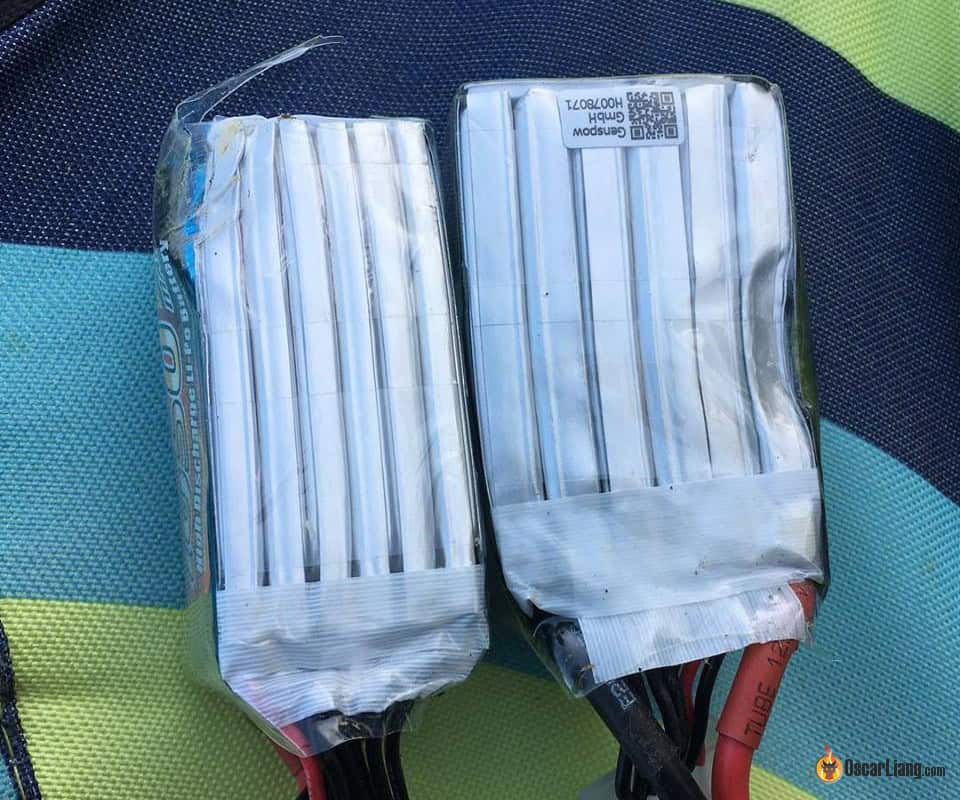


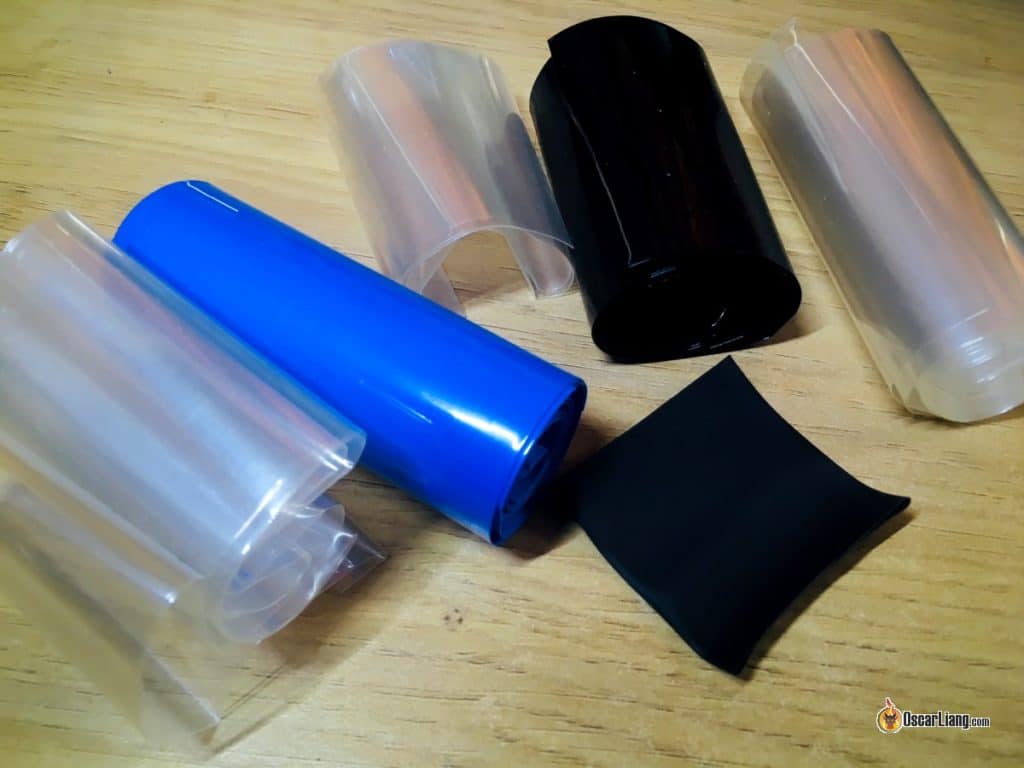
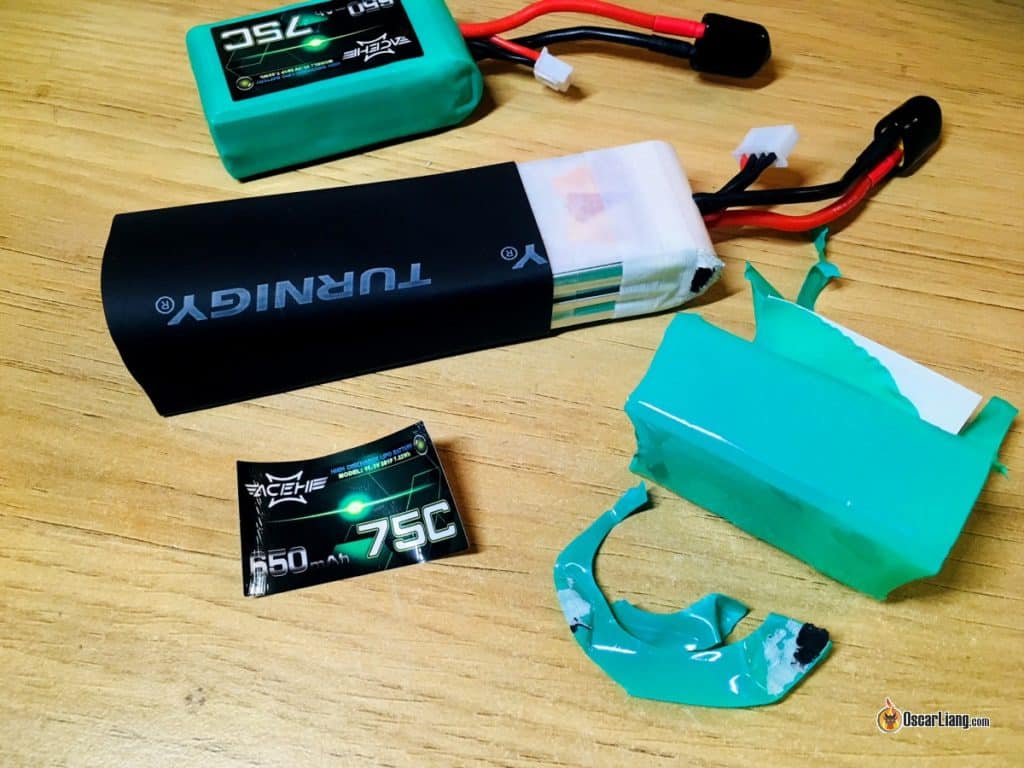




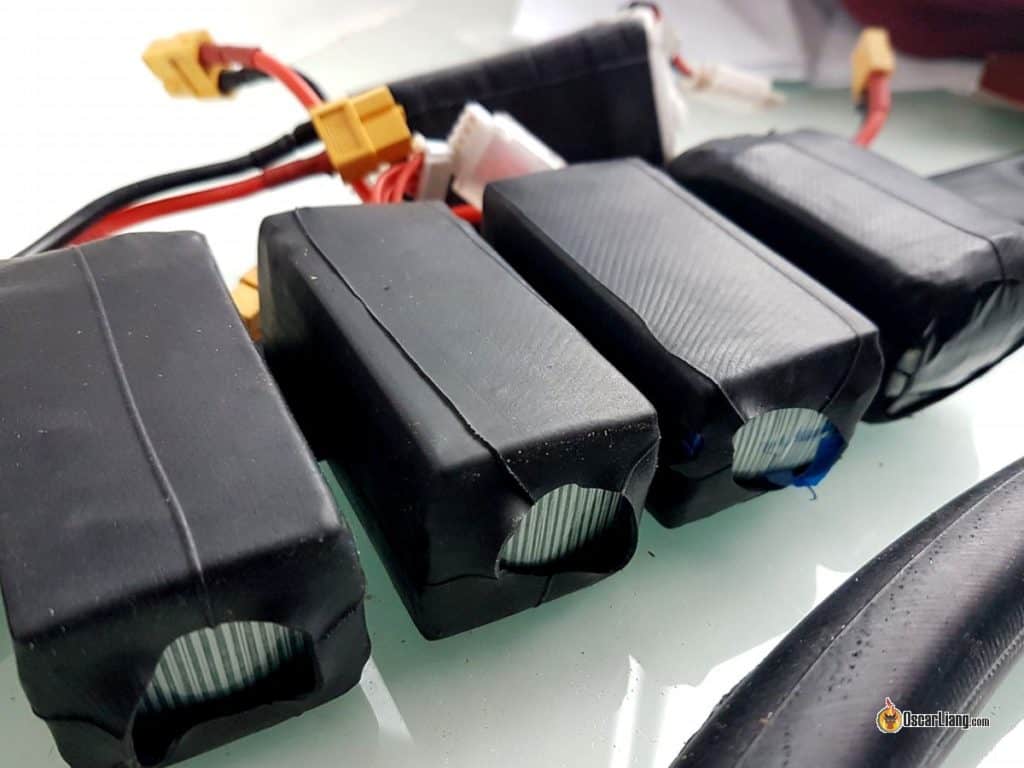
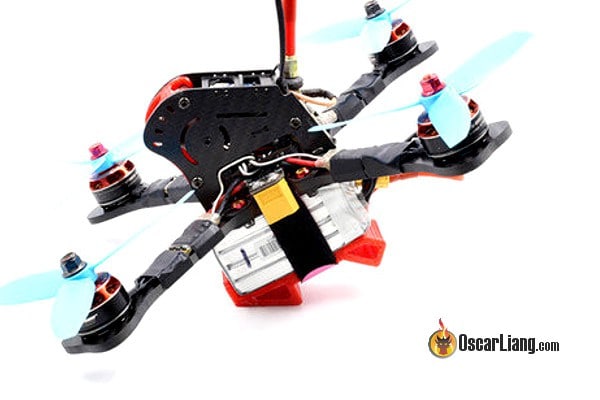
20 comments
Damage to LiPos always seems to happen on the exposed part of the battery and rarely on the side that is in contact with the quad. You can cut the weight of the PVC corners in half by only putting them on the top.
Hi Oscar, yes this is a old post but I was looking for ideas to protect lipo’s. I would recommend not to use bike inner tubes for batteries, the inner tubes are made from butanol, yep it’s a Butane compound which is highly flammable, put it this way i use old inner tubes as a fire lighter as they burn very hot and nice and slowly.
surely this is a raindrop in a hurricane when it comes to a lipo fire?
There is a little bit more complicated, but much more durable way to protect batteries.
Plastic PET bottle from yogurt or else shrieked to the size of battery. You will need to make wooden template to make that battery armor, do not even try to shrink on a battery.
We call it “battery armor”, as it is very stiff and durable, and also very light – about 7g. Also it does not give batteries to puff, and they seem to last a little longer.
Here is a video from my teammate, it explains how to make it:
youtube.com/watch?v=i_hhbrPRoU4
With this method, it might be even better to not shrink it fully, but leave some air between battery and plastic – the air bubbles would absorb part of the impact energy and further protect the battery.
(all theory, haven’t tried battery shrink wrapping myself yet)
Hi god of FPV Oscar Liang,
i’ve made a video for my french fpv friends to show your tips for LIPO protection:
https://youtu.be/GbB5pvuweh4
:D short video but just to illustrate it :D
That’s awesome dude! I will share it
i didnt expect so much :P just to inform that i used your idea to be fair :)
But thanks a lot dude :)
Great but one concern: In this video a lighter is being used while the document suggests to use hot air gun. It is risky.
Dear Oscar
I have been flying with this carbon fiber protector (banggood.com/Realacc-Carbon-Fiber-Battery-Protection-Board-with-Tie-Down-Strap-for-X-Frame-kit-p-1111041.html) and could not be happier. Of course, I am not an expert so the 8.55gr additional is not an issue for me and all my batteries are in quite good shape. I cannot recommend it enough
More important than the inner tube wheel diameter (eg 20″, 26″, 29″, 700c) is the tyre width they are designed for (eg 23c, 28c, 1.25″, 1.95″, 2.3″). What sizes are people using on 4s batteries?
Thanks,
to be honest i am not sure. Maybe go to a bike repair shop and ask if they have any useless tyre you can get :)
Hey Oscar,
thanks for these tips. One concern: I wonder what would happen in case of a LIPO-fire having that tape around? Maybe it could even lead to more serious consequences.
Martin
Fire will just melt through the tape, shouldn’t make fire any more or less dangerous. But the corners provide better protection to reduce the chance of damage to battery.
Hi, here is a video with my battery, showing disassembly cell after prop hit one cell…. show attention on welded sheets
youtube.com/watch?v=4lDd02aVCU0&t=10s
there are also these Battery feet from Banggood too Great, your battery strap goes over them and they hold to the battery good, i use them and think they work well
banggood.com/FPV-Racing-Landing-Gear-Battery-Protector-Board-3D-Printed-TPU-Yellow-Green-Red-p-1140905.html
Or you can buy hardcase lipos like the Tattu ones.
I like your idea of securing balance leads.
Overall it feels like the battery is an “added part” to the racing quad
Some kind of cage protecting batteries would be more than welcome for beginners frame.
Batteries dimensions being standard It shouldn’t be hard to design a universal 4S aluminium cage that may also serve as a landing gear
Just throwin’ ideas :)
There were frame designs back in 2015 that allowed you to put the battery inside the frame so it gets protected entirely. But it didn’t become popular because the extra weight with the design.
Hi Oscar. Another one to try is 26″ mountain bike inner tube, fits 4s packs perfectly. you can also cut a small band of it to secure balance plugs. Its very cheap and batteries even grip the strap/frame better. Adds 10 to 15 grams.